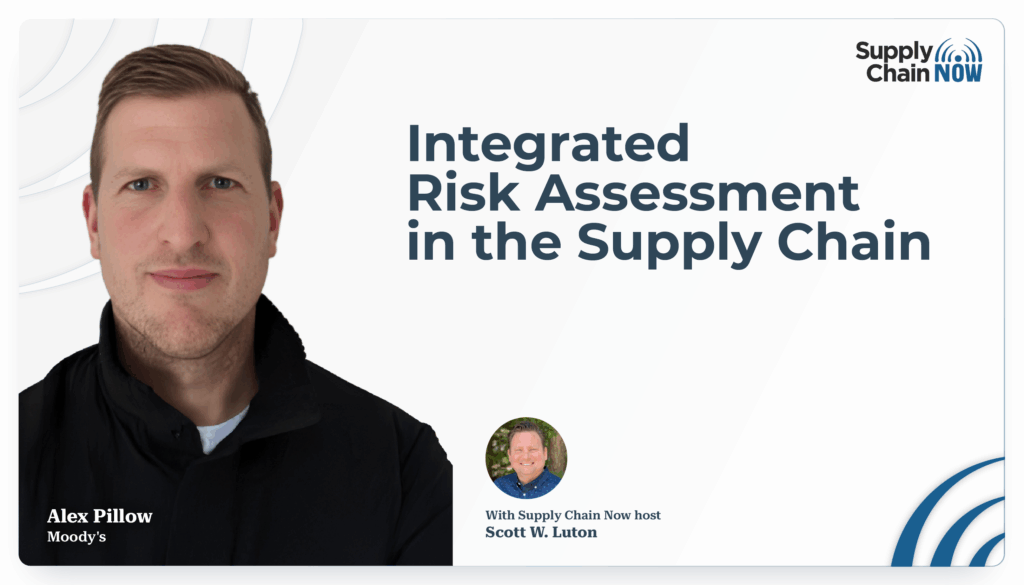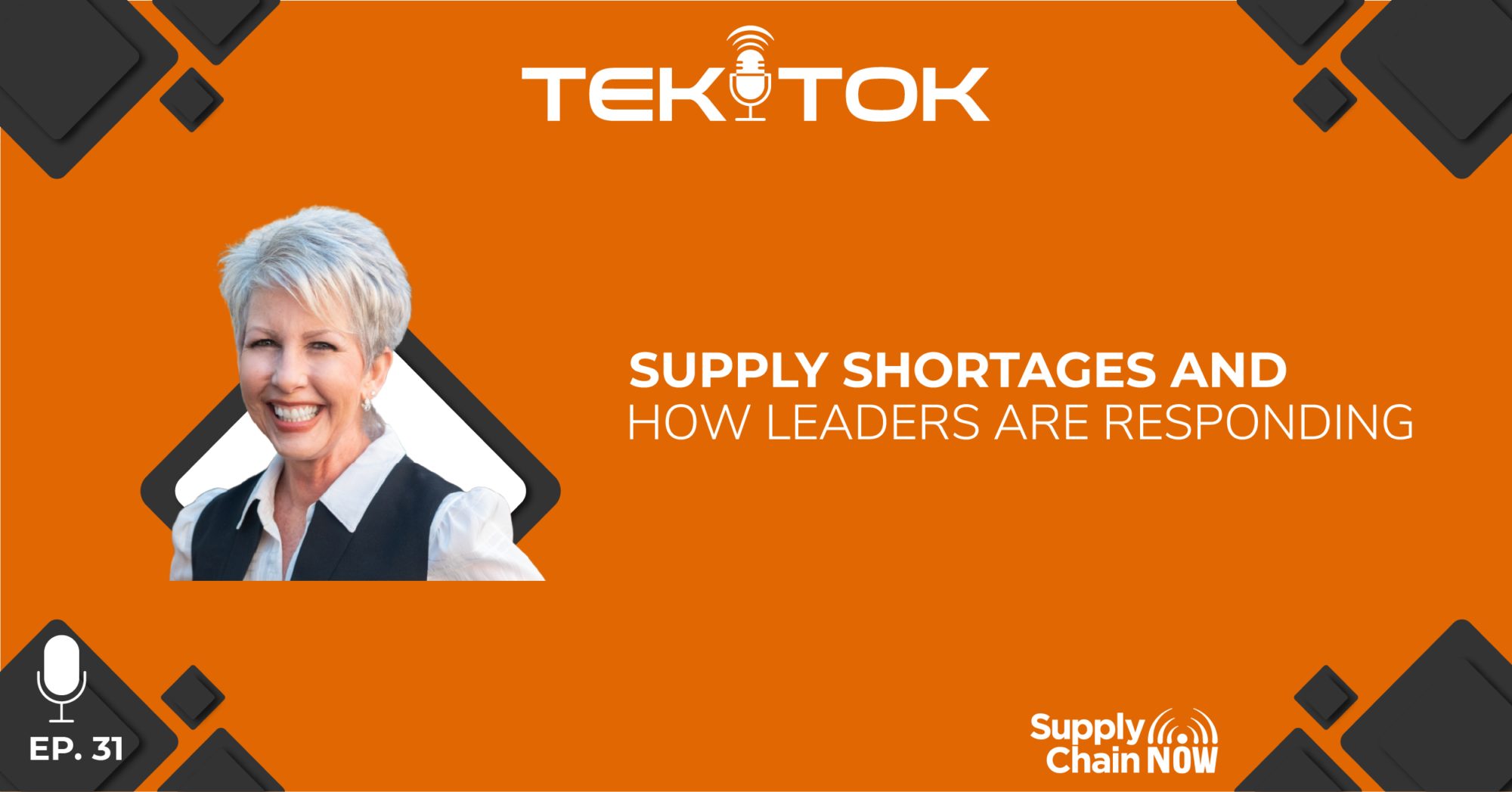Intro/Outro (00:01):
Welcome TekTok Digital Supply Chain podcast, where we will help you eliminate the noise and focus on the information and inspiration that you need to transform your business, impact supply chain success and enable you to replace risky inventory with valuable insights. Join your TekTok, host Karin Bursa, the 2020 Supply Chain Pro to Know of the Year. With more than 25 years of supply chain and technology expertise and the scars to prove it, Karin has the heart of a teacher and has helped nearly 1000 customers transform their businesses and tell their success stories. Join the conversation, share your insights, and learn how to harness technology innovations to drive tangible business results. Buckle up. It’s time for TekTok, powered by Supply Chain Now.
Karin Bursa (01:13):
Well, welcome supply chain movers and shakers. Karin Bursa here, and I want to thank you for tuning into TekTok. You know, on this episode, we’re going to address supply chain shortages, and we’re going to copy some strategies for market leaders. That’s right. I want you to learn from the best. After all, imitation is the sincerest form of flattery. So, with that in mind, in May of 2021, Enrique Alvarez, he’s the host of Logistics with Purpose; Kelly Barner, the host of Dial P for Procurement; and the one and only Scott Luton, founder of Supply Chain Now, and I, got together. And we were discussing the bounce back begins, and I got to tell you, I was optimistic. I was super optimistic. This is in May of 2021. So, check out episode number 639.
Karin Bursa (02:14):
Okay. So, I had this power packed cast of supply chain experts together, and we discussed a number of factors that included a long list of product shortages for things like chicken, lumber, microchips, gas, steel, metals, automobiles, chlorine, and, yes, even ketchup packets. And guess what? Here we are 10 months later, and many of these items and hundreds of others are still in short supply. And, I might add that we’re also dealing with container shortages, trucker shortages, and human power, manpower shortages. So, we’ve got even more shortages that are impacting our ability to produce and move the products we need to market. So, these shortages now combined with record inflation. So, in the U.S. that inflation is above 7.5%, 7.5%. Inflation is above 7.5%. And that has happened just over this past year. That’s a 40-year high.
Karin Bursa (03:37):
So, for some of you listening today, it has never been this high in your lifetime. And, the result is that it’s sending prices skyrocketing in some markets. So, product shortages, inflation increasing, higher prices are one of the outcomes, right? Supply and demand. You probably learn that in college. When supply is short and demand is high, people are willing to pay more. Well, that’s the reality that we’re living in today.
Karin Bursa (04:10):
Here’s the impact. So, the average U.S. household is really being hit hard by these changes. So, the economist at the University of Pennsylvania, Wharton School of Business, right, so very prestigious, these economists found that the average household is spending $3500 more today than they were in 2020 for the exact identical basket of goods, $3500 more a year today than they did in 2020. All right, let’s break that down. That’s nearly $300 a month. That’s substantial and it’s hitting all areas in the consumer’s pocketbook.
Karin Bursa (05:00):
So, listen, the pandemic exposed a number of vulnerabilities in global supply chains. And I really believe that today we are more aware of just how global and interdependent our supply chain networks are. But with that in mind, we’ve got to remember that our businesses are not islands. They are networks, and those networks are comprised of customers and suppliers in addition to our own ability to sell and produce and distribute goods. So, we have to adopt a network thinking and we need to have that network minds set about how we plan our supply teams to prepare our businesses to thrive in the future, right? So, the widespread nature of today’s supply chain constraints is limiting the effectiveness of any individual action. You’ve got to tap in to a more comprehensive strategy to really combat these challenges.
Karin Bursa (06:11):
So, I started researching some of these contributing factors to these shortages, and I have a few suggestions for what you can do now to help your business navigate through these supply shortages. So, get your pen and paper ready, and let’s take a look at what the leaders are doing now and what we can adopt, what we can copy, what we can imitate to improve our businesses. Are you ready?
Karin Bursa (06:48):
So, the first opportunity is looking at recalibrating to reduce risk. That’s right. I want to emphasize the word recalibrate here. So, companies that are effectively navigating the current environment, they are finding ways to both sense demand and sense supply changes, right? Sense demand changes and sense supply changes. That means looking at some new demand and supply signals, right? The outcome is evident. It gives them insights and allows them to respond and course correct faster. So, this means that you should plan and re-plan more often, more frequently. There is simply just too much happening in the market to solely depend on your monthly, your quarterly, or your annual planning cadence. We’ve got to be tapping the latest and greatest signals in the marketplace to align our business today.
Karin Bursa (08:05):
So, the second technique that I’m seeing leaders are leveraging to help them navigate these shortages is that they are expanding their supplier networks. Yes. You heard me correctly. They are expanding their supplier networks. They are looking for alternate sources of supply.
Karin Bursa (08:30):
Okay. Okay. All right. I hear you guys. I hear you out there, supply chain movers and shakers. I hear you. I think I just heard a universal grown. You are probably thinking that the increase in complexity would represent an increase in workload associated for you, the planning team, with a bigger supply portfolio and managing more orders that are smaller to address the same level of demand. Well, I hear you and I’ve got you. This is hard if, and underscore if, this is hard if you are managing your business on Excel spreadsheets. However, if you have a digital supply chain planning solution, it’s time to tap into the power that’s at your fingertips. It’s time to think in terms of automation and considering strategies around supplier liquidity.
Karin Bursa (09:39):
So, what do I mean by supplier liquidity? It is the ability to make changes faster, where you can actually accelerate your ability to on or offboard suppliers and tap into new sources of critical material or finish goods or additional capacity. This is going to give you tremendous flexibility, and it’s going to reduce the time and effort needed to rebalance your orders between suppliers or transportation providers or transportation routes, or even production facilities.
Karin Bursa (10:21):
I see this happening in consumer goods and food and beverage industries. These industries, consumer goods and food and beverage, have been leveraging contract manufacturers and co-packing trading partners to increase their flexibility across their global networks. So, they were well positioned to really leverage these partners in capacity across their global networks so that they could focus those efforts and crank it up or crank it down as needed.
Karin Bursa (11:03):
You know, as I think about this, the apparel industry has also done really well in this area. Many of the apparel brands have leveraged contract manufacturing and sourcing partners for years, and they are doing some really interesting things as they rebalance their supply and production networks. You know, some of that started with the need to move production out of China and to leverage other partners in the industry, leverage other geographic producers. So, they’re moving their production and supply needs around in a global framework. You need to think about how to apply that to your business, your production capacity, and in fact how you’re managing your suppliers.
Karin Bursa (12:00):
All right. Next up, model your constraints. Okay. In 2022, I’m surprised I even have to suggest this, but let’s be honest, supply chain movers and shakers, many of you are not leveraging constraint-based supply or replenishment planning today. I know I’m not going to name names. But I know many of you are still operating in an unconstrained environment, unconstrained of about how you produce or supply. I’m here to tell you those days are over. If you are unconstrained, your system, or maybe you’re back to Excel, or maybe you’re relying on your ERP system, is telling you that you can get 100% of anything you want. Sounds good to me. But it’s simply not true unless you’re living in some alternate universe that has zero friction and lots and lots of availability. We’re going to be operating in this constrained global environment for at least another year. And I wish it wasn’t true, but it is. So, keep in mind that your constraints include production constraints, storage capacity constraints, distribution, volume constraints, and transportation. And, I know you’ve been feeling those transportation constraints.
Karin Bursa (13:45):
So, if your replenishment planning process is unconstrained today, it is time for an upgrade. You need a reality check and the reality is your network is full of constraints, and you’ll never get a clear picture until you start incorporating those constraints into your supply chain planning. Additionally, replenishment planning is an ideal business process for automation. That’s right. Can you imagine automatically managing 90% of your replenishment orders? Sounds like an alternate universe, doesn’t it? You can do it if you’ve got those constraints modeled. So, enough said for today on that topic, but think about constraint-based planning. It’s a strategy that market leaders are using and seeing tremendous success with.
Karin Bursa (14:55):
All right. So, next up, I want you to go back and look at opportunities to reduce product portfolio complexity, reduce product portfolio complexity. Okay. I am really impressed with the number of companies that I’ve worked with that have done this throughout the pandemic. Why you might ask? Well, if you narrow your product portfolio down, you’re going to get more efficient production runs and you don’t have to fragment your efforts across areas that offer lower volume options. So, the benefits of product rationalization are huge. Yes, yes, yes. I did say huge, H-U-G-E. They are huge. Simplicity in supply chain is simply magic. So, look for those opportunities if you haven’t already done so.
Karin Bursa (15:48):
And, an added benefit of product rationalization is the ability to focus demand on a narrower set of options. This is going to lower the number of product configurations you need to consider, the number of changeovers that occur in production, the safety stock requirements across your network. All of these things can drastically improve your ability to optimize constraints, reduce complexity, and the result, the outcome is going to be a more predictable supply, your ability serve your customers with less effort.
Karin Bursa (16:37):
So, keep in mind that increasing capacity is often measured in years, not months. So, one way you can quickly go out and harness capacity is by narrowing down the number or types of products to be produced within your network. So, simplifying your product portfolio and tapping into additional suppliers is a quicker path to success. You know, supply chain movers and shakers, I got to tell you, I remain confident that we, as supply chain professionals, are going to emerge from the pandemic stronger and with more resilient supply chains. If, and I underscore if, we are able to learn from these hard lessons and take appropriate actions now, we are all going to be better prepared to weather any storm that comes in the future.
Karin Bursa (17:43):
So, if imitation is in fact the sincerest form of flattery, let’s imitate the leaders. Let’s make these changes within our networks today and start combating these shortages that we’re faced with. So, let me give you that list again. So, first I mentioned recalibrating to reduce risk, right? Do your cadence-based planning, but recalibrate more frequently, plan more frequently, ingest new demand and supply signals so that you are constantly tuning your plan the closer you are to executing that plan.
Karin Bursa (18:32):
Number two, expand your supplier network and think in terms of supplier liquidity. Yes, I am encouraging you to add new suppliers and to get them in place and certified and available on your network so that you can crank it up or ratchet it back as needed. And that ability, that flexibility to increase or decrease as your business deems necessary, I’m referring to as supplier liquidity.
Karin Bursa (19:05):
So, the third thing we talked about that these leaders are doing is that they model their constraints. They model their constraints, which means they know how much they can produce, how much they can store, what volume can be distributed, and what transportation availability will impact delivery of that customer’s perfect order. And if you are operating in an unconstrained world, listen, supply chain movers and shakers, you need to gimme a set of those rose-colored glasses because that world simply doesn’t exist anymore.
Karin Bursa (19:50):
We are living in a world that is filled with supply chain constraints, and you need the ability to model those in your supply chain planning platform. Think of it as creating a digital twin of what your physical network looks like in order to plan more effectively. This is also going to give you some huge bonuses around the ability to automate certain business processes, which means you, as a planner, get to be hands free and work on some more interesting opportunities in the supply chain.
Karin Bursa (20:34):
And then, finally reduce product portfolio complexity. Maybe, I should have started with this one. But reduce that product portfolio complexity to give you that narrower set of products to be produced, sourced, moved throughout your network with greater reliability. Simplicity is magic. It’s magic.
Karin Bursa (20:59):
So, I’m going to challenge you, supply chain movers and shakers, I’m going to challenge you to select at least one of these four strategies from market leaders. And, remember that imitation is in fact the sincerest form of flattery. So, pick one, recalibrate to reduce risk, expand your supplier network, model your constraints, and reduce product portfolio complexity.
Karin Bursa (21:27):
I hope these insights are going to help you raise your supply chain IQ. And on the topic of raising your supply chain IQ, be sure to check out the wide variety of digital content at supplychainnow.com. While you’re there, I want you to find TekTok, that’s T-E-K-T-O-K, and subscribe. Tell your colleagues to listen in and join me for the next episode.
Karin Bursa (21:54):
This is Karin Bursa, host of TekTok, digital supply chain podcast, helping you to eliminate the noise and focus in on the information and inspiration you need to transform your business. Let’s drive supply chain success and enable you to replace risky inventory with valuable insights. We’ll see you next time on TekTok.



